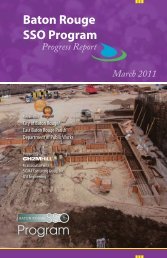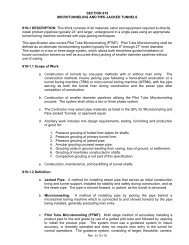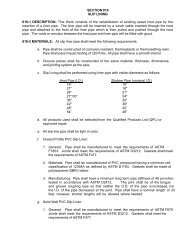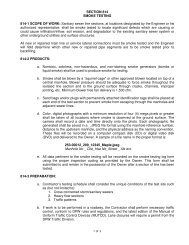SECTION 819 MICROTUNNELING AND PIPE-JACKED TUNNELS ...
SECTION 819 MICROTUNNELING AND PIPE-JACKED TUNNELS ...
SECTION 819 MICROTUNNELING AND PIPE-JACKED TUNNELS ...
- No tags were found...
Create successful ePaper yourself
Turn your PDF publications into a flip-book with our unique Google optimized e-Paper software.
1. Install and maintain an instrumentation system to monitor and detect movement of<br />
the ground surface and adjacent structures. Establish vertical control points at a<br />
distance from the construction areas that avoids disturbance due to ground<br />
settlement.<br />
2. Installation of the instrumentation shall not preclude the Engineer, through an<br />
independent contractor or consultant, from installing instrumentation in, on, near,<br />
or adjacent to the construction work. Access shall be provided to the work for such<br />
independent installations.<br />
3. Instruments shall be installed in accordance with the Contract Documents and the<br />
manufacturer’s recommendations.<br />
4. Monitoring locations given on the Contract Documents are not inclusive and are<br />
given to assist the Contractor. Additional locations may need to be established<br />
by the Contractor. The Contractor is responsible for all construction induced ground<br />
movement and the monitoring thereof.<br />
b. Surface Settlement Monitoring<br />
1. Establish monitoring points on all critical structures.<br />
2. Minimum monitoring points are indicated on the Contract Documents.<br />
3. Record location of settlement monitoring points with respect to construction<br />
baselines and elevations. Record elevations to an accuracy of 0.01 feet for each<br />
monitoring point location. Monitoring points should be established at locations and<br />
by methods that protect them from damage by construction operations, tampering,<br />
or other external influences.<br />
4. Ground surface elevations shall be recorded on the centerline ahead of the<br />
tunneling operations at a minimum of 100-foot intervals or at least three<br />
locations per tunnel drive. For sewers greater than 60-inch diameter, also record<br />
similar data at approximately 20 feet each side of the centerline. Settlement<br />
monitoring points must be clearly marked by studs or paint for ease of locating.<br />
5. Monitoring points to measure ground elevation are required at a distance of 0 feet, 10<br />
feet and 20 feet from the perimeter of the shaft on each of four radial lines, the radial<br />
lines being at 90 degrees to each other.<br />
6. Railroads. Monitor ground settlement of track subbase at centerline of each track.<br />
7. Utilities and Pipelines. Monitor ground settlement directly above and 10 feet before<br />
and after the utility or pipeline intersection.<br />
c. Reading Frequency and Reporting. The Contractor shall submit to the Engineer,<br />
records of readings from the various instruments and survey points.<br />
1. Instrumentation monitoring results to be read at the frequency specified and unless<br />
otherwise specified, shall be started prior to the zone of active excavation<br />
reaching that point, and shall be continued until the zone of active excavation has<br />
passed and until no further detectable movement occurs.<br />
2. Surface settlement monitoring readings shall be taken:<br />
i. Prior to the zone of active excavation reaching that point,












